This article was written by dietetic student Emily Kuettel & reviewed by Melanie Betz MS, RD, CSR, CSG.
An Indian diet for CKD patients is possible with some ingredient swaps, allowing the Masala – or spice blends – to help make the foods delicious, rather than with a ton of salt!
Table of Contents
Background on Indian Diet & Culture
The Indian diet and culture related to eating varies widely based on location. Each region has its own food, influenced by different traditions, religions, and culture. One commonality among regions is the distinct Masala – or spice blends – used widely in Indian cooking which produce delicious aromas and unique flavors.
Cooking traditional meals for family and guests is a big part of life in India. The Indian saying “Atithi Devo Bhava”, equates guests to God.
It is common for meals to be served family-style, allowing family members and guests to feed themselves. During a casual dinner, it is common for the homemaker to keep an eye on food and water and bring more when needed. Requests, especially more food, are welcomed. For celebratory meals, one family member may volunteer to tend to the table, which includes bringing out courses, feeding, and serving the group.
Cutlery is traditionally not used in Indian culture, and instead, bread is torn and used to scoop up curry and rice dishes. This is because food and eating is intended to engage all of the senses, including touch. Not to mention, no forks or spoons to wash – makes for an easier clean-up!
Food is a significant part of the Indian culture, it brings together families, friends, and guests – often celebrating great food and better company!
Indian Diet for CKD Patients
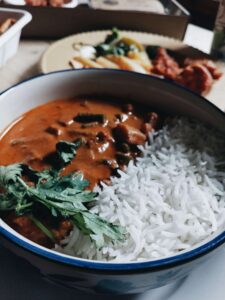
A traditional Indian diet incorporates a variety of vegetables and plant-based cooking, which offers tremendous health benefits to any person, especially people with kidney disease. Plants are nutrient-dense, meaning they contain many vitamins and minerals relative to calories.
In Indian cooking, the spices do most of the talking – which is also great for kidney disease, as these spices offer tons of flavor, rather than flavoring food with salt and other high sodium ingredients.
A healthy diet for kidneys is different for everyone. However, for most people it involves cutting back on foods that are high in sodium, animal protein, artificial phosphorus and for some, potassium. The kidneys are not able to filter out some of these nutrients and byproducts, which can cause toxic levels in the body.
Fortunately, a traditional Indian diet is very much in line with most kidney diet recommendations! We will examine some common ingredients and identify ways to alter dishes to make them kidney friendly. Let’s take a look!
Healthy Foods for an Indian Diet for CKD Patients
Vegetables
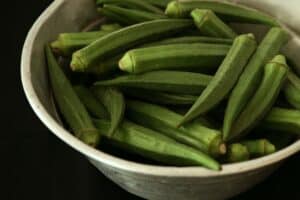
Indian cooking features lots of nutritious vegetables including cauliflower, peas, spinach, potatoes, onion, eggplant, green peppers, mushrooms, tomatoes, okra.
Vegetables are perhaps the most important part of a healthy diet for CKD patients. Because Indian food tends to have so many veggies, it is a great choice for kidney health! We know that people who eat a more plant-based diet have slower progression of kidney disease.(1)
All fruits and vegetables can be enjoyed on the CKD diet, but some have higher potassium than others, including spinach, potatoes, and tomatoes. Raisins are also commonly used in Indian dishes, and can add lots of potassium if you eat too many of them.
If you have high blood potassium, it may be a good idea to avoid too much of these higher potassium vegetables. Don’t fret – these vegetables can still be eaten in moderation. Make sure to ask your dietitian how much potassium is right for you. For many people with early stages of CKD, a diet high in potassium is good for you!
Basmati Rice
Basmati rice is a fragrant and nutty long-grain rice. In Hindi, “bas” means aroma, and “mati” means full of” – so basmati is literally full of aroma (and flavor!). Basmati is typically a white rice, although brown basmati rice is also available.
Traditional CKD nutrition recommendations may suggest white rice because it has less potassium and phosphorus. But, we now know that most of the phosphorus and potassium isn’t absorbed. And, brown rice is an excellent source of other nutrients, including fiber. Brown basmati rice is a wonderful food choice for an Indian diet for CKD patients.
If you have diabetes, too much rice could raise your blood sugar. Limit how much rice you add to your plate, and fill up on the veggies instead!
Breads
Dining etiquette varies among regions, but in some regions in India, it is common for people to use pieces of bread to scoop and eat their meal – no cutlery needed!
- Traditional Indian breads include paratha, naan, and roti.
- Paratha is a fried, unleavened bread, rolled out several times to achieve a flakey texture.
- Naan is a soft, leavened flatbread that is generally coated in ghee, or clarified butter.
- Roti is an unleavened flatbread that are thinner than naan.
There are many variations which include chapati, tandoori roti, and others. These breads may be consumed at every meal in a traditional Indian diet.
Bread products can be enjoyed on the CKD diet, but it can be easy to over-indulge on buttery naan – it’s delicious! Make sure to practice portion control. A one-ounce serving of these breads provides 80 calories. However, the typical piece of bread may be closer to 3.5 oz, or 280 calories.
Also noteworthy, unless you make them from scratch, these bread products generally are made with white flour, so you may be passing on some key nutrients that are found in whole wheat and whole grain flours. However, these products can certainly be enjoyed in moderation.
Similar to rice, it is important for people with diabetes to limit how much bread they eat to control blood sugar. If you are following a diabetic diet you may be watching your carbohydrate intake. One “carbohydrate choice” is any of the following:
- Paratha – 1/6 piece, 1 oz
- Naan – 3 ¼ in square, 1 oz
- Roti – 1 oz
Legumes
Indian cooking uses many various legumes, including lentils, beans and peas. Legumes are an excellent plant-based source of protein and can be used in place of meats in many dishes, especially in Indian cooking. Similar to meat, they stew very nicely. And, add an unmatched boost of nutrition, including fiber, magnesium, and B-vitamins.
Red and yellow lentils are an Indian staple, specifically for Dal (also spelled Dhal, Dahl, Daal) a traditional Indian lentil stew. Curries may be made with pigeon peas or chickpeas – both options are delicious!
If potassium is a concern for you, you can reduce the amount of potassium in this healthy, plant-based protein. Soak your dried legumes or drain and soak your canned legumes prior to cooking. This is a method called “leaching” which decreases potassium by about 50%! Canned beans tend to have less potassium than dried. Make sure to find a “no salt added” or “low sodium” can!
Chutney
Indian chutneys are relishes made from fresh fruits, vegetables, and spices. They are a great and flavorful way to add even more kidney-friendly fruits and vegetables!
Chutneys may accompany breakfast, lunch, or dinner, adding wonderful flavors and colors to each dish. They can also be enjoyed with traditional Indian breads, Pongal (sweet rice dish), or dosa (rice pancake with fermented batter).
Some kidney-friendly chutney flavors include onion, red bell pepper, cucumber, tamarind, pineapple, ginger, mint and garlic. Coconut, mango, beetroot, peanut, tomato and papaya chutney are also great choices for people who do not have to limit potassium.
Foods to Limit on an Indian Diet for CKD Patients
Dairy
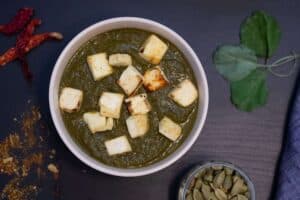
In Indian cooking, dairy is used make foods creamy, tangy, or more flavorful. Common dairy products used in Indian cooking include paneer (fresh curd cheese), milk, yogurt, and ghee (clarified butter).
Dairy foods are similar to meat in that they are all high in potassium and phosphorus. But, you do not need to cut them out completely! When cooking and eating Indian, try to choose either dairy or meat in your dish – not both. Think of dairy and meat as different options in the same food group.
If you prefer meat, tips to decrease your dairy intake when cooking and eating Indian include:
- Don’t eat the yogurt sauce every day (or only have a little)
- Replace milk with flax or rice milk
- Limit the paneer.
Coconut Milk
Canned coconut milk is a non-dairy milk made from the white flesh of a coconut and is often added to soups and curries to make them rich and creamy. Coconut milk varies in potassium depending on the brand, but tends to be quite high in saturated fat. Again, the key is enjoy everything in moderation! Some recipes require coconut milk – so use it! Just perhaps not every day.
When using coconut milk, make sure it says “unsweetened” on the label, or else your dish will be way too sweet.
Avoid Sneaky Potassium & Phosphorus Additives
When you are buying plant-based milks, make sure to stay away from “enriched” products, as these are likely to contain higher amounts of potassium and phosphorus. Many plant-based milks have potassium and phosphorus additives.
Look for ingredients that have “potassium” or “PHOS” in them. Some sneaky phosphorus names include calcium phosphatate, sodium acid pyrophosphate, and phosphoric acid.
Chicken, Goat and Lamb
Chicken, goat and lamb are very common ingredients in Indian cooking. Popular dishes include vindaloo, where cooked meats that have been marinated in a very flavorful spice mixture, and curries.
All animal proteins are rich in phosphorus and protein. Eating large amounts of protein is associated with faster progression of kidney disease. All animal proteins should be limited, if possible. For most people, 3-4 ounces of animal protein per meal is a good rule of thumb. Chicken and fish are more heart healthy compared to beef, lamb or goat.
Or – go vegetarian with one of the many delicious lentil, bean or vegetable curry options! Plant proteins tend to be much better for your kidneys.
Try it yourself!
Kick up the spice in your kitchen! Try out some recipes that are appropriate for most people with CKD.
- Vegetable Curry
- Paneer
- Indian spice blend (Recipe curtesy of Glebe Kitchen Blog)
- Red Lentil Dal (Recipe curtesy of the Wanderlust Kitchen)
- Red Bell Pepper Chutney (Recipe curtesy of Padhus Kitchen)
Happy Eating!
Melanie

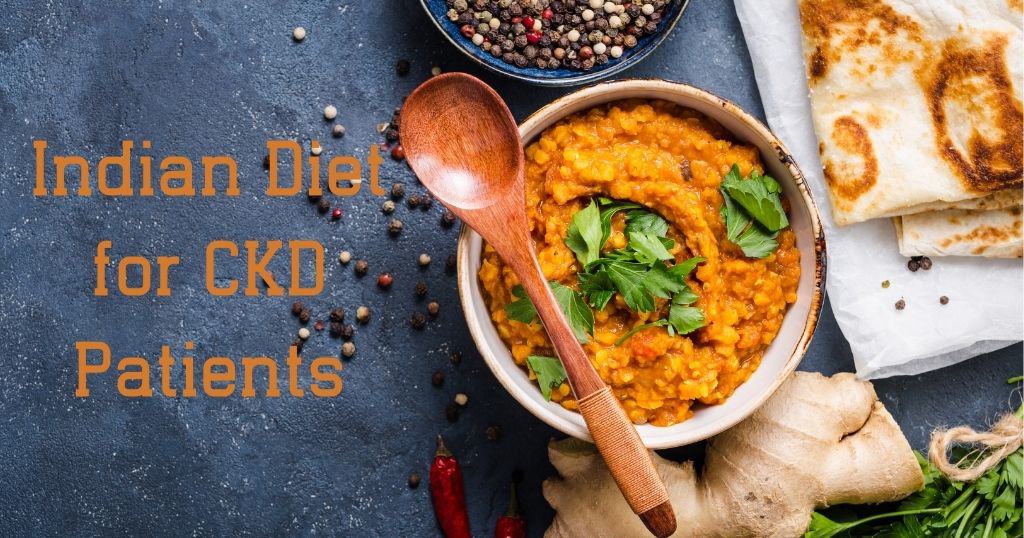
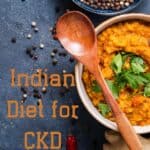
Please advise before I go for my eGFR and potassium level test, my doctor recommends 2 weeks of vegetarian meals
This is an interesting recommendation! Without knowing more, I’m not sure what exactly you should eat or why they made that recommendation.
dear melanie….
i thought lentils are not good for ckd patients.
please comment.
Nope! Lentils are actually a WONDERFUL plant based protein source for people with CKD. These types of food used to be taboo for kidney disease, but the guidelines have changed significantly. Learn more about this here!
What about Mango Lassi? Love me some Lassi!
Yum! Me too! My biggest concern about this would be potential added sugar. I imagine this varies significantly. So, you would just want to keep that in mind. They also are made with yogurt, so if phosphorus is a concern, this should be considered. Lastly, IF you have high potassium, mango is pretty high in potassium and one could easily consume a LARGE amount of mango at once in this “smoothie” form. Hope that helps!
Thanks for the information 🙏
Got to know so many things👍
Hi, Melanie! My family spent 3 years in West Bengal, India, so are appreciative of Indian foods and their regional varieties. It is my experience that most rotis and parathas are traditionally made with “atta”, which means “wheat flour” in Hindi. However, some restaurants might use the less expensive white flour. Often, the type of flour is noted in the description. And parathas are loaded in fat to achieve the flaky layers. Roti is a better choice for those watching the waistline, and I’ve observed Indians switching to roti for this reason when we lived there.
Also, did you know that silken tofu can be subbed 1:1 for coconut milk? That might be a good option for kidney patients who can consume tofu. From a culinary perspective, silken tofu, once blended, acts as a cream base for soups, sauces, and salad dressings. From a nutrient perspective, per 3 oz portion, Nasoya brand has 4 g protein, 4% Potassium, 0 saturated fat, and 40 calories. (My nephrologist and dietician recommend moderate protein and potassium for me, but of course every CKD patient is different.)
I love this! Thank you so much for all of your comments! Wonderful suggestions 🙂
You’re welcome! Thank you for including a variety of cuisines in your blog. It helps to know the full breadth of possibilities while following a medical diet. It doesn’t have to be dull!
Thanks for the info
What about Alcohol drinking
Is there any particular drink one should avoid
Thanks in advance
Of course! In general, kidney disease is not a contraindication to drinking alcohol in moderate amounts. No more than 1 drink per day for women and 2 for women. However, definitely ask your doctor if alcohol is okay for you!